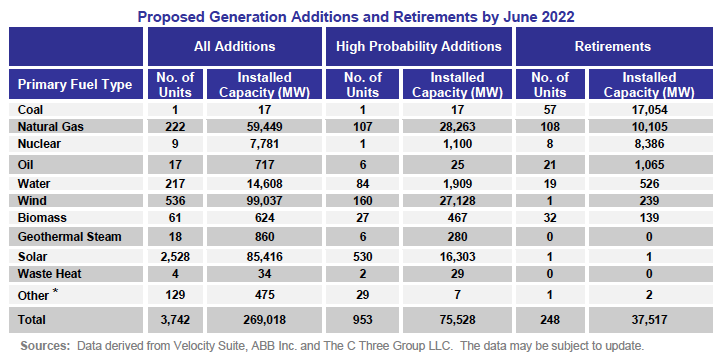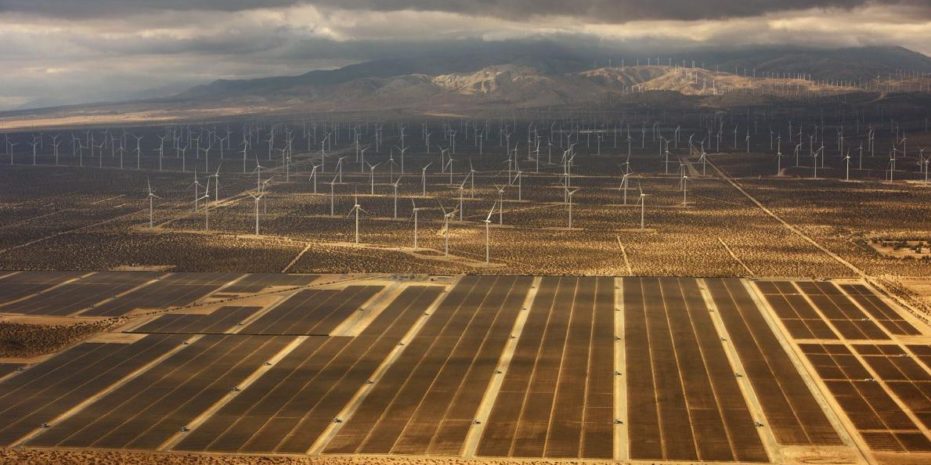The Federal Energy Regulatory Commission’s (FERC) monthly Energy Infrastructure Update provides an interesting snapshot into how the federal government is planning for changes in the U.S. power mix.
And while we have in the past noted the wide discrepancy between the document’s “New Generation in Service” figures for monthly solar capacity installed versus more rigorous assessments by Wood Mackenzie and other organizations, we consider it a reliable document for changes to the nation’s fleet of large-scale, conventional power plants.
But in the latest Energy Infrastructure Update (with data for May 2019), it is the “Proposed Generation Additions and Retirements” table which is particularly interesting. In this assessment, FERC suggests that a total of 28.2 GWac of coal, gas and oil-fired power plants will retire by June 2022, versus 28.3 GW of “high probability additions”, which are almost entirely gas plants.

Coal plants make up 17.1 GWac of those proposed retirements, with 5 additional coal-fired units totaling 3.1 GW scheduled for retirement since the previous Energy Infrastructure Update, released only one month prior.
Meanwhile, FERC is forecasting 8.4 GWac of nuclear power retirements, versus only 1.1 GW of “high probability additions”, for a net loss of 7.3 GW.
Solar and wind to more than replace nukes
But while FERC is predicting this decline in the nuclear fleet, it also shows more than 27 GWac of wind and 16 GWac of solar projects with a “high probability” to arrive over the next three years. Even with the lower average capacity factors of wind (estimated 35%) and solar (estimated 26%) this is expected to generate more than 2x the annual electricity output that the lost nuclear power plants represent.
And with relatively flat electric demand, these will eat into the economics of other conventional power plants, driving more retirements of coal, nuclear and gas plants.
And if anything FERC’s numbers do not tell the full story of this transition; in particular we see FERC’s numbers on solar as unrealistically low. First, FERC does not count small-scale, distributed solar in its Energy Infrastructure Update, thus missing around 1/3 of the total solar market.
Additionally, for large-scale solar FERC’s numbers are more conservative than that of major market analysts. In its latest U.S. Solar Market Insight report, Wood Mackenzie has found 28 GWdc of large-scale solar with power purchase agreements. The organization has forecast that 13 GWdc of solar at all scales will be installed in 2019, with even more expected each year in 2020 and 2021, meaning more than 40 GWdc over the next three years.

We at pv magazine have questioned whether Wood Mac’s forecasts are also overly conservative, particularly in light of the very large volumes of solar projects in the interconnection queues of the nation’s seven grid operators, with nearly 8 GWac of solar projects already approved for interconnection in Texas alone.
Regardless, as time goes on FERC’s reports forecast more and more new renewable energy capacity, along with more and more retirements of coal and other conventional resources. We can expect that future reports will show the energy transition that is underway in the U.S. electricity sector in even sharper relief, as the agency’s projections catch up with the facts on the ground.
This content is protected by copyright and may not be reused. If you want to cooperate with us and would like to reuse some of our content, please contact: editors@pv-magazine.com.









By submitting this form you agree to pv magazine using your data for the purposes of publishing your comment.
Your personal data will only be disclosed or otherwise transmitted to third parties for the purposes of spam filtering or if this is necessary for technical maintenance of the website. Any other transfer to third parties will not take place unless this is justified on the basis of applicable data protection regulations or if pv magazine is legally obliged to do so.
You may revoke this consent at any time with effect for the future, in which case your personal data will be deleted immediately. Otherwise, your data will be deleted if pv magazine has processed your request or the purpose of data storage is fulfilled.
Further information on data privacy can be found in our Data Protection Policy.